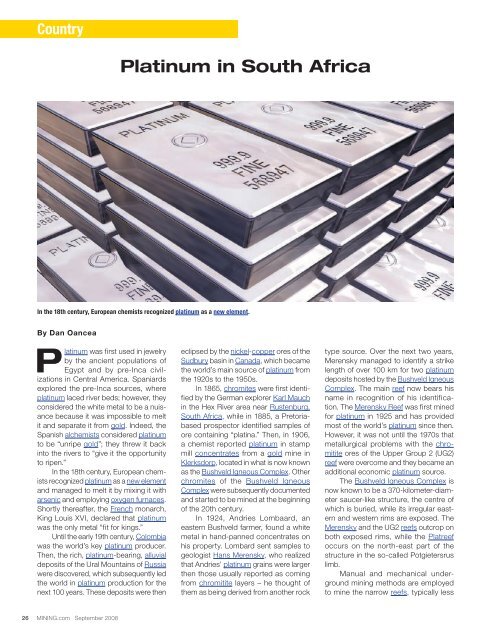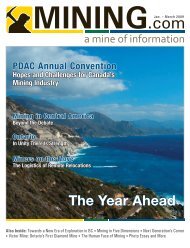You also want an ePaper? Increase the reach of your titles
YUMPU automatically turns print PDFs into web optimized ePapers that Google loves.
Country<br />
By Dan Oancea<br />
Platinum was first used in jewelry<br />
by the ancient populations of<br />
Egypt and by pre-Inca civilizations<br />
in Central America. Spaniards<br />
explored the pre-Inca sources, where<br />
platinum laced river beds; however, they<br />
considered the white metal to be a nuisance<br />
because it was impossible to melt<br />
it and separate it from gold. Indeed, the<br />
Spanish alchemists considered platinum<br />
to be “unripe gold”; they threw it back<br />
into the rivers to “give it the opportunity<br />
to ripen.”<br />
In the 18th century, European chemists<br />
recognized platinum as a new element<br />
and managed to melt it by mixing it with<br />
arsenic and employing oxygen furnaces.<br />
Shortly thereafter, the French monarch,<br />
King Louis XVI, declared that platinum<br />
was the only metal “fit for kings.”<br />
Until the early 19th century, Colombia<br />
was the world’s key platinum producer.<br />
Then, the rich, platinum-bearing, alluvial<br />
deposits of the Ural Mountains of Russia<br />
were discovered, which subsequently led<br />
the world in platinum production for the<br />
next 100 years. These deposits were then<br />
26 <strong>MINING</strong>.<strong>com</strong> September 2008<br />
Platinum in South Africa<br />
In the 18th century, European chemists recognized platinum as a new element.<br />
eclipsed by the nickel-copper ores of the<br />
Sudbury basin in Canada, which became<br />
the world’s main source of platinum from<br />
the 1920s to the 1950s.<br />
In 1865, chromites were first identified<br />
by the German explorer Karl Mauch<br />
in the Hex River area near Rustenburg,<br />
South Africa, while in 1885, a Pretoriabased<br />
prospector identified samples of<br />
ore containing “platina.” Then, in 1906,<br />
a chemist reported platinum in stamp<br />
mill concentrates from a gold mine in<br />
Klerksdorp, located in what is now known<br />
as the Bushveld Igneous Complex. Other<br />
chromites of the Bushveld Igneous<br />
Complex were subsequently documented<br />
and started to be mined at the beginning<br />
of the 20th century.<br />
In 1924, Andries Lombaard, an<br />
eastern Bushveld farmer, found a white<br />
metal in hand-panned concentrates on<br />
his property. Lombard sent samples to<br />
geologist Hans Merensky, who realized<br />
that Andries’ platinum grains were larger<br />
then those usually reported as <strong>com</strong>ing<br />
from chromitite layers – he thought of<br />
them as being derived from another rock<br />
type source. Over the next two years,<br />
Merensky managed to identify a strike<br />
length of over 100 km for two platinum<br />
deposits hosted by the Bushveld Igneous<br />
Complex. The main reef now bears his<br />
name in recognition of his identification.<br />
The Merensky Reef was first mined<br />
for platinum in 1925 and has provided<br />
most of the world’s platinum since then.<br />
However, it was not until the 1970s that<br />
metallurgical problems with the chromitite<br />
ores of the Upper Group 2 (UG2)<br />
reef were over<strong>com</strong>e and they became an<br />
additional economic platinum source.<br />
The Bushveld Igneous Complex is<br />
now known to be a 370-kilometer-diameter<br />
saucer-like structure, the centre of<br />
which is buried, while its irregular eastern<br />
and western rims are exposed. The<br />
Merensky and the UG2 reefs outcrop on<br />
both exposed rims, while the Platreef<br />
occurs on the north-east part of the<br />
structure in the so-called Potgietersrus<br />
limb.<br />
Manual and mechanical underground<br />
mining methods are employed<br />
to mine the narrow reefs, typically less




